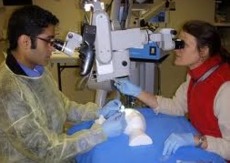Ophthalmologic Emergencies
|
Ophthalmologic emergencies are the abnormalities or diseases that develop in the eyes or the areas coming within the ambit of visual system. Such emergencies can pose a severe threat to vision of the person and cause damage to retinal areas if not treated well in time. Proper diagnosis is very necessary to find out the root-cause of infections or other disorders developing in the eyes so that an apt pattern of treatment can be undergone.
What are Ophthalmologic Emergencies?
 Ophthalmology basically refers to diseases, physiology and anatomy of an eye. Hence, emergencies related to ophthalmology are directly or indirectly related to eye problems. Eye is one of the vital parts of human body and consists of various important parts like retina, iris, eyelids, lens, choroid and ciliary body, cornea and conjunctiva. Hence, infection in any part of the eye is equally harmful if not tackled in time. Damage to retina is quite serious as it directly affects the seeing abilities of a person. Ophthalmology basically refers to diseases, physiology and anatomy of an eye. Hence, emergencies related to ophthalmology are directly or indirectly related to eye problems. Eye is one of the vital parts of human body and consists of various important parts like retina, iris, eyelids, lens, choroid and ciliary body, cornea and conjunctiva. Hence, infection in any part of the eye is equally harmful if not tackled in time. Damage to retina is quite serious as it directly affects the seeing abilities of a person.
Emergencies of ophthalmology are the situations wherein an urgent attention is necessary to address eye problems and prevent further health issues. Loss of eye-sight is a permanent loss and regular eye checkup is the only reliable option to keep a track on changes taking place in the visual system.
Ophthalmologic Emergencies Types
Ophthalmologic issues may arise due to a number of factors. Age is the most important factor and may lead to severe emergencies related to eye-sight. Eye muscles become weak and tissues present in the region become inefficient as a man gets older and leads to improper supply of blood and other resources to cells present therein. This leads to lack of coordination between various areas of eyes and puts excess stress on the muscles that perform efficiently. Such over-stressed muscles lead to increase in blood pressure in the ophthalmic region and impact the eyesight.
Diseases like diabetes harm a person's eyesight severely and cause considerable damage to retinal areas. Regular eye examination is very important to trace signs of retinopathy in such patients. Photocoagulation laser therapy is highly beneficial in treating ophthalmologic issues like proliferative retinopathy, macular edema and non-proliferative retinopathy. Some disorders like endophthalmitis and mucormycosis may lead to blindness or can even be risky for a patient's life. Thus, thorough medical examination is extremely important to cure such infections right in the initial stages to avoid systemic infection. Older patients may suffer from herpes zoster infection leading to anterior uvetitis and keratitis. Unattended ocular infection may cause synechiae formation leading to loss of vision.
Temporal arteritis is a common eye disease that generally arises with an increase in age (usually above 50 years) and may lead to temporal artery abnormalities or even vision loss. Vision loss is severe and acute and may impact one or both the eyes. Joint pain, fatigue, fever, Polymyalgia Rheumatica and malaise are some of the prime early signs of the disease. Most of the people suffering from temporal arteritis loose vision due to ischemia to the optic nerve. Transient diplopia or transient visual loss may lead to permanent loss of sight.
Retinal artery occlusion is an ophthalmologic disorder in which the arterial supply to the retina is affected. Thromboembolic, thrombotic or embolic occlusion acute and painless vision loss are some of the early signs of the disease. 'Cherry red spot' is usually detected in central retina artery occlusion, wherein the red choroid can be seen in the fovea and is surrounded by pale ischemia. Some may also suffer from blockage of retinal veins which may further result into retinal hemorrhages. Hypertension is a general risk factor for retinal vein occlusion as it leads to thickening of artery walls and leading to compression of central nerve. This can directly affect the seeing abilities of the person.
Retinal detachment is a severe ophthalmologic emergency in which the retina detaches from epithelium, a retinal pigment. Other risk factors are exudative retinal detachment and diabetic tractional retinal detachment. High mypoia, retinal abnormalities, ocular medications, ocular surgery and trauma can pose a threat to eyes and lead to retinal detachment.
Double vision is another major ophthalmological concern. It may be monocular, binocular or three ocular. Monocular diplopia is caused due to cataract, dry eye or refractive error. Binocular diplopia is mainly due to misalignment of eyes and can be caused due to neuromuscular junction, extraocular muscle or nerve disease.
Ophthalmologic emergency should be handled very carefully and patiently. Proper diagnosis of the disease should be done under expert supervision in order to initiate an apt treatment. Surgical methods are often useful in tackling most of the emergencies related to ophthalmology while some minor emergencies can be cured by regular medication. Regular medical checkup and proper eye health is very important to avoid or control the intensity of ophthalmological disorders.
|